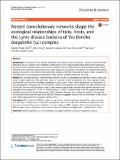Por favor, use este identificador para citar o enlazar a este item:
http://hdl.handle.net/10261/141629COMPARTIR / EXPORTAR:
 SHARE SHARE
 CORE
BASE CORE
BASE
|
|
| Visualizar otros formatos: MARC | Dublin Core | RDF | ORE | MODS | METS | DIDL | DATACITE | |

| Campo DC | Valor | Lengua/Idioma |
|---|---|---|
| dc.contributor.author | Estrada-Peña, Agustín | - |
| dc.contributor.author | Sprong, Hein | - |
| dc.contributor.author | Cabezas-Cruz, Alejandro | - |
| dc.contributor.author | Fuente, José de la | - |
| dc.contributor.author | Ramo, Ana | - |
| dc.contributor.author | Coipan, Elena Claudia | - |
| dc.date.accessioned | 2016-12-19T12:09:58Z | - |
| dc.date.available | 2016-12-19T12:09:58Z | - |
| dc.date.issued | 2016 | - |
| dc.identifier | doi: 10.1186/s13071-016-1803-z | - |
| dc.identifier | issn: 1756-3305 | - |
| dc.identifier.citation | Parasites and Vectors 9(1): 517 (2016) | - |
| dc.identifier.uri | http://hdl.handle.net/10261/141629 | - |
| dc.description.abstract | [Background]: The bacteria of the Borrelia burgdorferi (s.l.) (BBG) complex constitute a group of tick-transmitted pathogens that are linked to many vertebrate and tick species. The ecological relationships between the pathogens, the ticks and the vertebrate carriers have not been analysed. The aim of this study was to quantitatively analyse these interactions by creating a network based on a large dataset of associations. Specifically, we examined the relative positions of partners in the network, the phylogenetic diversity of the tick's hosts and its impact on BBG circulation. The secondary aim was to evaluate the segregation of BBG strains in different vectors and reservoirs. [Results]: BBG circulates through a nested recursive network of ticks and vertebrates that delineate closed clusters. Each cluster contains generalist ticks with high values of centrality as well as specialist ticks that originate nested sub-networks and that link secondary vertebrates to the cluster. These results highlighted the importance of host phylogenetic diversity for ticks in the circulation of BBG, as this diversity was correlated with high centrality values for the ticks. The ticks and BBG species in each cluster were not significantly associated with specific branches of the phylogeny of host genera (R = 0.156, P = 0.784 for BBG; R = 0.299, P = 0.699 for ticks). A few host genera had higher centrality values and thus higher importance for BBG circulation. However, the combined contribution of hosts with low centrality values could maintain active BBG foci. The results suggested that ticks do not share strains of BBG, which were highly segregated among sympatric species of ticks. [Conclusions]: We conclude that BBG circulation is supported by a highly redundant network. This network includes ticks with high centrality values and high host phylogenetic diversity as well as ticks with low centrality values. This promotes ecological sub-networks and reflects the high resilience of BBG circulation. The functional redundancy in BBG circulation reduces disturbances due to the removal of vertebrates as it allows ticks to fill other biotic niches. | - |
| dc.description.sponsorship | Parts of this work were performed under the umbrella of the COST project (TD1303). | - |
| dc.publisher | BioMed Central | - |
| dc.relation.isversionof | Publisher's version | - |
| dc.rights | openAccess | - |
| dc.subject | Borrelia burgdorferi (s.l.) | - |
| dc.subject | Vertebrates | - |
| dc.subject | Ecological networks | - |
| dc.subject | Centrality | - |
| dc.subject | Phylogenetic diversity | - |
| dc.subject | Ticks | - |
| dc.title | Nested coevolutionary networks shape the ecological relationships of ticks, hosts, and the Lyme disease bacteria of the Borrelia burgdorferi (s.l.) complex | - |
| dc.type | artículo | - |
| dc.identifier.doi | 10.1186/s13071-016-1803-z | - |
| dc.relation.publisherversion | https://doi.org/10.1186/s13071-016-1803-z | - |
| dc.date.updated | 2016-12-19T12:09:59Z | - |
| dc.description.version | Peer Reviewed | - |
| dc.language.rfc3066 | eng | - |
| dc.rights.license | http://creativecommons.org/licenses/by/4.0/ | - |
| dc.contributor.funder | European Commission | - |
| dc.relation.csic | Sí | - |
| dc.identifier.funder | http://dx.doi.org/10.13039/501100000780 | es_ES |
| dc.identifier.pmid | 27662832 | - |
| dc.type.coar | http://purl.org/coar/resource_type/c_6501 | es_ES |
| item.fulltext | With Fulltext | - |
| item.openairecristype | http://purl.org/coar/resource_type/c_18cf | - |
| item.cerifentitytype | Publications | - |
| item.grantfulltext | open | - |
| item.openairetype | artículo | - |
| Aparece en las colecciones: | (IREC) Artículos | |
Ficheros en este ítem:
| Fichero | Descripción | Tamaño | Formato | |
|---|---|---|---|---|
| Borreliaburgdorferi.pdf | 2,53 MB | Adobe PDF |  Visualizar/Abrir |
CORE Recommender
PubMed Central
Citations
17
checked on 23-abr-2024
SCOPUSTM
Citations
30
checked on 19-abr-2024
WEB OF SCIENCETM
Citations
24
checked on 29-feb-2024
Page view(s)
200
checked on 24-abr-2024
Download(s)
240
checked on 24-abr-2024

